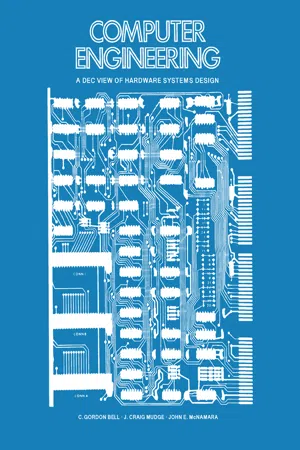
eBook - PDF
Computer Engineering
A DEC View of Hardware Systems Design
- 608 pages
- English
- PDF
- Available on iOS & Android
eBook - PDF
Computer Engineering
A DEC View of Hardware Systems Design
About this book
Computer Engineering: A DEC View of Hardware Systems Design focuses on the principles, progress, and concepts in the design of hardware systems. The selection first elaborates on the seven views of computer systems, technology progress in logic and memories, and packaging and manufacturing. Concerns cover power supplies, DEC computer packaging generations, general packaging, semiconductor logic technology, memory technology, measuring (and creating) technology progress, structural levels of a computer system, and packaging levels-of -integration. The manuscript then examines transistor circuitry in the Lincoln TX-2, digital modules, PDP-1 and other 18-bit computers, PDP-8 and other 12-bit computers, and structural levels of the PDP-8. The text takes a look at cache memories for PDP-11 family computers, buses, DEC LSI-11, and design decisions for the PDP-11/60 mid-range minicomputer. Topics include reliability and maintainability, price/performance balance, advances in memory technology, synchronization of data transfers, error control strategies, PDP-11/45, PDP-11/20, and cache organization. The selection is a fine reference for practicing computer designers, users, programmers, designers of peripherals and memories, and students of computer engineering and computer science.
Frequently asked questions
Yes, you can cancel anytime from the Subscription tab in your account settings on the Perlego website. Your subscription will stay active until the end of your current billing period. Learn how to cancel your subscription.
At the moment all of our mobile-responsive ePub books are available to download via the app. Most of our PDFs are also available to download and we're working on making the final remaining ones downloadable now. Learn more here.
Perlego offers two plans: Essential and Complete
- Essential is ideal for learners and professionals who enjoy exploring a wide range of subjects. Access the Essential Library with 800,000+ trusted titles and best-sellers across business, personal growth, and the humanities. Includes unlimited reading time and Standard Read Aloud voice.
- Complete: Perfect for advanced learners and researchers needing full, unrestricted access. Unlock 1.4M+ books across hundreds of subjects, including academic and specialized titles. The Complete Plan also includes advanced features like Premium Read Aloud and Research Assistant.
We are an online textbook subscription service, where you can get access to an entire online library for less than the price of a single book per month. With over 1 million books across 1000+ topics, we’ve got you covered! Learn more here.
Look out for the read-aloud symbol on your next book to see if you can listen to it. The read-aloud tool reads text aloud for you, highlighting the text as it is being read. You can pause it, speed it up and slow it down. Learn more here.
Yes! You can use the Perlego app on both iOS or Android devices to read anytime, anywhere — even offline. Perfect for commutes or when you’re on the go.
Please note we cannot support devices running on iOS 13 and Android 7 or earlier. Learn more about using the app.
Please note we cannot support devices running on iOS 13 and Android 7 or earlier. Learn more about using the app.
Yes, you can access Computer Engineering by C. Gordon Bell,J. Craig Mudge,John E. McNamara in PDF and/or ePUB format, as well as other popular books in Technology & Engineering & Mechanical Engineering. We have over one million books available in our catalogue for you to explore.
Information
Table of contents
- Front Cover
- Computer Engineering: A Dec View of Hardware Systems Design
- Copyright Page
- Table of Contents
- FOREWORD
- PREFACE
- ACKNOWLEDGEMENTS
- Chapter 1. Seven Views of Computer Systems
- Chapter 2. Technology Progress in Logic and Memories
- Chapter 3. Packaging and Manufacturing
- PART 1: IN THE BEGINNING
- PART 2: BEGINNING OF THE MINICOMPUTER
- PART 3: THE PDP-11 FAMILY
- PART 4: EVOLUTION OF COMPUTER BUILDING BLOCKS
- PART 5: THE PDP-10 FAMILY
- APPENDIX 1: An ISPS Primer for the Instruction Set Processor Notation
- APPENDIX 2: The PMS Notation
- APPENDIX 3: Performance
- BIBLIOGRAPHY
- INDEX